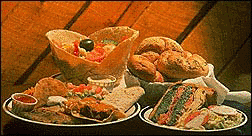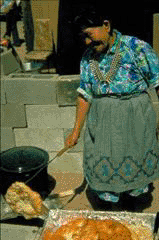|
6. |
In the United States Mexican-Americans comprise 60 percent of the
Hispanic/Latino population. Mexicans live predominantly in California,
Texas, Arizona, New Mexico, and Colorado. The difference between Mexican,
Puerto Rican, and other Latin American countries includes 500 years of
separate history, as well as entirely different native populations that
were present when the Spaniards arrived. Thus, the Mexican, Puerto Rican,
and Latin American cultures each have a completely different concept of
what foods are appropriate and what these foods are called. Food Habits and Their Relationship to Dietary Guidelines The Mexican diet of today is rich in a variety of foods and dishes that
represent a blend of pre-Columbian, Spanish, French and, more recently,
American culture. The typical Mexican diet is rich in complex
carbohydrates, which are provided mainly by corn and corn products, beans,
rice, and breads. The typical Mexican diet contains an adequate amount of
protein in the forms of beans, eggs, fish and shellfish, and a variety of
meats, including beef, pork, poultry, and goat. Because of the extensive
use of frying as a cooking method, the Mexican diet is also high in fat.
The nutrients most likely to be inadequately provided are calcium, iron,
vitamin A, folacin, and vitamin C. Eating Practices, Food Preferences and Food Preparation Techniques Traditionally, Mexicans ate four or five meals daily. The foods eaten
varied with factors such as income, education, urbanization, geographic
region, and family customs. The extent to which the traditional Mexican
meal pattern continues among Mexicans in the United States has not been
systematically studied. The three-meal pattern prevails, although whether
or not the major meal of the day occurs in mid-afternoon is unclear. The
daily meal pattern in the typical Mexican-American home varies according
to the availability of traditional foods and the degree of assimilation
into American society. With emigration to the United States, major changes occur in the
Mexican-American’s diet. Healthy changes include a moderate increase in
the consumption of milk, vegetables, and fruits, and a large decrease in
the consumption of lard and Mexican cream. The introduction of salads and
cooked vegetables has increased the use of fats, such as salad dressings,
margarine, and butter. Other less healthy changes include a severe decline
in the consumption of traditional fruit-based beverages in favor of
high-sugar drinks. Consumption of inexpensive sources of complex
carbohydrates, such as beans and rice, also has decreased as a result of
acculturation. In addition to the negative impact on the health of this
population, these dietary changes also may adversely affect the family’s
budget when low-priced foods are replaced with more expensive ones. Clinical studies have consistently reported a high prevalence of
obesity, cardiovascular disease, diabetes, dental caries, and over/under
nutrition in the Mexican-American population. Overweight and obesity are
higher in Hispanic women and children. Research also indicates that
Mexicans in the United States eat more meat and saturated fats than
Anglos, and use fewer low-fat dairy products. Mexicans also are less
likely to recognize high-fat foods. Approximately 10 to 12 percent of
Mexican-American adults have diabetes, with 95 percent of those having the
non-insulin-dependent type. Teaching Implications Health care providers need to understand Hispanic culture, beliefs,
norms, food practices, and terminology to assist clients. Providers need
to support and stimulate the preservation of healthy cultural food
practices among Mexican-American clientele. When appropriate, suggest
modifications of traditional dishes that are high in sodium, fat, and
sugar. Increase clients’ knowledge of healthy food selections from
typical American fare. Gain support from clients’ families to enhance
their acceptability of the diet. The diets of pregnant Mexican-American women of marginal social and
economic standing are deficient in dietary iron, vitamin A, and calcium.
Encourage the consumption of low-fat cheeses, lean red meat, fresh fruits,
and vegetables. Monitor beverage intake, as carbonated soft drinks and
presweetened drinks are widely consumed. Breastfeeding is widely practiced
in Mexico, although most Mexican-Americans use infant formula. Weaning
children from the bottle at one year of age is not widely practiced. Baby
bottle tooth decay is common in toddlers, suggesting that the child is put
to bed with a bottle. The health care provider may intervene with Hispanic clients and
communities in culturally sensitive ways, which includes viewing culture
as an enabler rather than a resistant force, incorporating cultural
beliefs into the plans of care, stressing familialism, and taking time for
pleasant conversation.
REFERENCES Caudle, P. (1993). Providing Culturally Sensitive Health Care to
Hispanic Clients. Nurse Practitioner, Volume 18:12. Delpapa, R., Mayer, J., et al (1990). Food Purchases Patterns in a
Latino Community: Project Salsa. Journal of Nutrition Education,
June, 133-35. Romero-Gwynn, E., Gwynn, D., et al (1992). Dietary Changes Among
Latinos of Mexican Descent in California. California Agriculture.
Volume 46:4. Mexican American Food Practices, Customs, and Holidays (1989).
American Dietetic Association. Additional resources addressing cultural diversity in nutrition
education: Cross-Cultural Counseling: A Guide for Nutrition and Health Counselors
(FNS 250). U.S. Department of Agriculture and U.S. Department of Health
and Human Services. Kittler, P. and Sucher, K. (1989). Food and Culture in America.
Van Nostrand & Reinhold, 1989. Nutrition, Food, and Culture. National Livestock and Meat Board,
Chicago, Illinois.
v Mexican-American
Source: Ohio State University Extension Fact Sheet
http://ohioonline.osu.edu/hyg-fact/5000/5255.html
v Puerto Rican
The Puerto Rican culture includes people whose ancestors and possibly current extended family members are from the Caribbean island of Puerto Rico. Their original language is Spanish. Under Spanish rule and then under American rule, Puerto Rico has never been an independent nation. Puerto Ricans are American citizens and can legally enter and leave the mainland. Migration flows circularly between the island of Puerto Rico and the mainland. Because of this circular migration, elements of both cultures thrive in both places, and a specific Puerto Rican "cultural type" is difficult to describe.
Food Habits and Their Relationship to Dietary Guidelines
The typical Puerto Rican diet has many positive aspects. This diet is high in complex carbohydrates such as breads, cereals, soda crackers, rice, and corn meal.
A typical diet also includes some calcium and milk products. Adult women will drink milk in cafe con leche (coffee with milk) and consume calcium in flan (custard).
Incomplete proteins, such as those found in legumes, rice, and beans, are often eaten. Meats eaten include chicken, pork sausage, turkey, beef, pork chops, spare ribs, and marinated pork. Fish is eaten, but in quantities smaller than other meats.
When available, viandas (starchy vegetables) are also included in the Puerto Rican diet. Viandas include plantains, green bananas, taniers, white and yellow sweet potatoes, and chayote squash. Lettuce salads with tomato are popular.
Increasing the calcium intake and the varieties of vegetables would improve the typical Puerto Rican diet. The diet is generally high in calories, complex carbohydrates, fats, and sodium.
Almost 70 percent of the food on the island of Puerto Rico is imported from the United States. Because of this the Puerto Rican diet– particularly the diets of younger generations–has become very Americanized. Favorite foods include pizza, hot dogs, canned spaghetti, cold cereal, and canned soups. Fast food restaurants are also popular. Some Puerto Rican families living on the mainland shift away from traditional dietary patterns. Others maintain their ethnic food patterns after living on the mainland for several decades. Bilingual children can play a major role in promoting dietary changes and modifications.
The population has a tendency toward high blood pressure, heart disease, diabetes (three to five times higher than the general population), cancer, arthritis, gastrointestinal disorders, and obesity.
Nutritional objectives should involve: encouraging selection of foods from all food groups; drinking plenty of water, maintaining ideal body weight, encouraging the use of low-fat dairy products, encouraging the consumption of unsugared fruit juices, teaching a greater variety of preparation styles, and introducing a greater variety of vegetables. The population should also be discouraged from eating sugar and simple carbohydrates, and using excessive fats in cooking.
Eating Practices, Food Preferences and Food Preparation Techniques
Puerto Rican foods are not spicy like Mexican foods, but they do have a mild, distinctive taste. They frequently use a seasoning called sazon, which is mostly MSG. Other common seasonings are annato (a yellow coloring similar to saffron), cilantro, and sofrito (a seasoning sauce used in cooking made from lean cured ham, onion, green pepper, cilantro, and garlic sauteed in oil).
Teaching Implications
Teachers may benefit from developing a trust relationship and engaging learners on a personal level. For example, when passing out papers, hand them to each individual rather than passing them down the row. This will show that "personal touch." Also, do not be offended if you are asked personal questions. Puerto Ricans typically like to touch and feel close (both physically and emotionally) to those around them.
Enlisting the help of a member of the community–such as an elder or older woman, both of whom are well-respected–may benefit your presentations. An indigenous educator that speaks the language is also beneficial. When using written materials remember that many people cannot read English or Spanish.
Possible meeting places may include the church or English-as-a-Second Language classes. Teaching the women may be easier. Frequently, however, the men’s support is needed before the women will listen.
REFERENCES
Common Puerto Rican Foods, Herbs and Spices (1992), New Jersey State WIC Program, New Jersey State Department of Health.
Looker, A., Loria, C.M., Carroll, M.D., McDowell, M.A., Johnson, C.L. (1993). Calcium intakes of Mexican American, Cubans, Puerto Ricans, Non-Hispanic whites and Non-Hispanic Blacks in the United States. Journal of the American Dietetic Association, Volume 93:11, pp 1274-1278.
Sanjur, Diva, (1995). Hispanic Foodways, Nutrition, and Health. Allyn and Bacon Publisher.
Warrix, M., et al, (1993). Cultural Competencies: A Nutrition Wellness Model. Concurrent session at the Ohio Association of Home Economics annual meeting.
Additional resources addressing cultural diversity in nutrition education:
Cross-Cultural Counseling: A Guide for Nutrition and Health Counselors (FNS 250). U.S. Department of Agriculture and U.S. Department of Health and Human Services.
Kittler, P. and Schuer, K. (1989). Food and Culture in America. Van Nostrand & Reinhold, 1989.
Nutrition, Food, and Culture. National Livestock and Meat Board, Chicago, Illinois.
|
v
La Cocina—Southwestern Cuisine
|
|
The Spanish explorers owe a great deal to the native population, who introduced corn to their diet. In return, the Indians benefited from European vegetables introduced when Spanish settlers later colonized the region.
Virtually all Southwestern dishes make use of four main ingredients: the tortilla, pinto bean, cheese and chile. The tortilla is a round, wafer-thin bread made from coarsely ground dough (masa) that’s usually cooked in a pan until it has a light-brown texture. Taking the standard refried beans (frijoles) one step further, cooks use dark pink or purple pinto beans, some of which grow organically in the state.
|
Perhaps the most essential ingredient for
any recipe is the famous chile pepper that grows in 2,000 different
varieties. The Capsicum species, encompassing a wide range of
colors, sizes, shapes and spiciness, are roasted, stewed, fried, cooked
or simply added fresh off the plant. Chile generally comes in either a
red or green sauce. Depending on the variety, growth and harvest
conditions, "hotness" can vary. Your waiter will know which is
hotter. If you’re the adventurous sort, ask for "Christmas"–a
sample of red and green chile served side-by-side. |
|
tasty treat any time of the day. Sopaipillas are
commonly served as a side dish, but some specialty restaurants will stuff
them with chiles, onions, beans, cheese and meat.
|
|
|
Follow it with a small bowl of green chile stew laden with chunks of meat, beans and potatoes, and you’ll feel satisfied until supper. For a spicier dish, try the carne adovada, strips of pork marinated in red chile, herbs and spices and then baked until the meat is tender. Of course, a margarita or a tall, cold glass of your favorite beer will go nicely with any of these meals.
Tamales are another classic dish, made with a highly seasoned cornmeal
and meat filling, and then steamed in a scalding corn husk to retain the
natural juices. Similar to a burrito, the enchilada is a corn tortilla
smothered in tangy green or red chile sauce and piled with cheese, onions,
lettuce, green pepper and ground meat. No visit to New Mexico would be
complete without sampling genuine Native American cuisine. The Navajo taco is
an open-faced taco heaped with fresh lettuce, tomatoes, refried beans,
guacamole, a dab of sour cream and your choice of red or green chile—all
served on a flat, puffy tortilla or a piece of fry bread. Pan dulce is
an Indian sweet bread. Piki bread uses corn that’s finely ground,
cooked in boiling water until it’s a mush, and then spread over a hot flat
surface. The mush cooks instantly and peels off in a paper-thin sheet before
being rolled up and eaten with stew.


